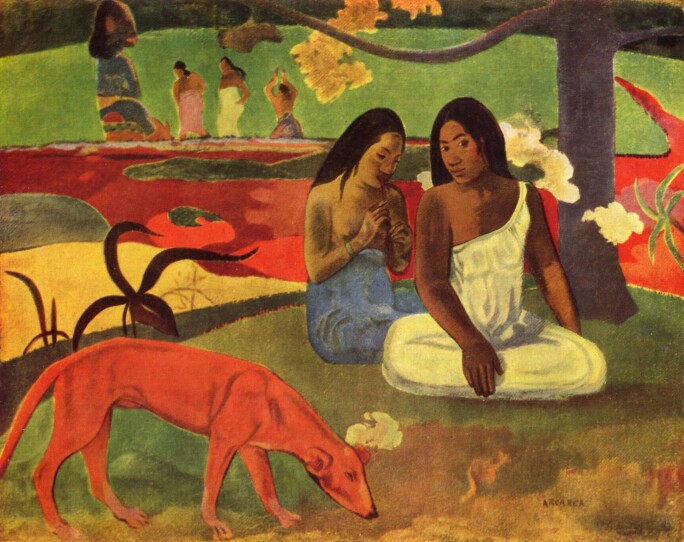About Post-Impressionism
What is Post-Impressionism?
Following the eighth and last Impressionist exhibition in 1886, a group of young adherents began to extend the Impressionist project – the lyrical evocation of the subtle shifts and diffusions of natural light and atmosphere – into bold new territory. Their use of vibrant colors, emphasis on geometric forms and gestural brushwork prefigured the Fauvist, Cubist and Expressionist movements soon to come. Far from being merely a transitional faction, these artists created some of the most enduringly treasured works in the Western canon – among them, The Starry Night, Two Tahitian Women and A Sunday Afternoon on the Island of La Grande Jatte.

Post-Impressionism Characteristics and Style
The artists Paul Cézanne, Paul Gauguin, Georges Seurat and Vincent Van Gogh are virtually metonymous with fin-de-siècle European art, and each represents a discrete strain of Post-Impressionist innovation. Cezanne pioneered Synthetism, in which the artist's observations of nature and their emotions are brought into union on the canvas, often in flat, simplified forms that anticipate Cubism. Gauguin moved away from direct observation into the realm of imagination and augured the Primitivist movement with his fruitful decade in Polynesia. Seurat devised the distinctive technique of Pointillism, in which complex compositions are formed with tiny dots of pure color, much as mechanically and digitally color-separated images would be produced. Finally, Van Gogh developed a highly personal, emotionally reverberant style that inspired the Expressionist movements that would define the next century.

West Meets East, East Meets West
It is well-known that the Post-Impressionists were greatly inspired by the art of East Asia, especially ukiyo-e woodblock prints, whose distinctive division of scenes and flattening of planes directly informed the work of Van Gogh, Bonnard and Toulouse-Lautrec. The story of the Post-Impressionists’ influence upon the development of modern Asian art is more obscure. In the early 20th century, during a short-lived but heady moment of liberal eclecticism between the founding of the Chinese Republic and the ascendancy of Mao Zedong, many Chinese artists received government sponsorship to study art in Europe. Many then returned to develop a deft syncretism of Post-Impressionist perspectives, palettes and gestures with the venerable tradition of Chinese figurative painting. Among these artists were Lin Fengmian (林風眠), Xu Beihong (徐悲鴻), and Ding Yanyong (丁衍庸).
Impact and Legacy of Post-Impressionism
Among the artists who were directly influenced by the Post-Impressionists are Edvard Munch, whose iconic work The Scream was inspired by Van Gogh’s ferocity of color and gesture; Henri Matisse, who experimented with pointillism and other Post-Impressionist color theories before becoming a founding Fauve; and Georges Braque, whose painterly landscapes transformed into Cubist abstractions over the first decade of the 20th century. Among the countless contemporary artists who acknowledge a debt to the Post-Impressionists are Theo Meier, Bharti Kher and Red Grooms.
The works of the original Post-Impressionist painters are among the most expensive paintings ever sold, with Vincent Van Gogh’s Irises and L’Allée des Alyscamps and Cézanne’s Rideau, Cruchon et Compotier all topping $50 million at Sotheby’s.
These Post-Impressionist masters are well represented in public collections on both sides of the Atlantic, including the Metropolitan Museum of Art and the Solomon R. Guggenheim Museum in New York and the Musée d'Orsay and the Musée de l'Orangerie in Paris.
Timeline & History

Claude Monet, Impression, soleil levant, 1872 1874Louis Leroy’s scathing review of Claude Monet’s Impression, soleil levant becomes the source of the term Impressionism
Georges Seurat, A Sunday Afternoon on the Island of La Grande Jatte, 1884 1886The last Impressionist show is held in Paris; Seurat’s seminal pointillist composition A Sunday Afternoon on the Island of La Grande Jatte is included in the exhibition over some members’ objections
Vincent van Gogh, The Yellow House, 1888 1887Vincent Van Gogh and Paul Gauguin meet in Paris; the following year, they would stay together in the famous Yellow House in Arles
Paul Sérusier, Le Bois d'Amour à Pont-Aven, 1888 1888Les Nabis, a group of young artists of the Académie Julian in Paris, join together; members include Pierre Bonnard, Maurice Denis and Édouard Vuillard, and their eventual manifesto would open with the celebrated line: “Remember that a picture, before being a battle horse, a female nude or some sort of anecdote, is essentially a flat surface covered with colors assembled in a certain order.”
Paul Gauguin, Roches Noires Drawing, 1889, exhibition catalogue frontispiece 1889The Volpini exhibition in Paris is arranged by Gauguin; it includes work by Bernard, but Seurat is excluded and Theo van Gogh refuses to contribute his brother’s work
Vincent van Gogh, Self-Portrait, 1887 1890After shooting himself in the stomach, Vincent van Gogh dies on 29 July in Auvers-sur-Oise.
Paul Gauguin, Spirit of the Dead Watching, 1892 1891Gauguin visits Tahiti for the first time
Paul Cézanne, The Basket of Apples, 1890–1894 1895Ambrose Vollard gives Paul Cézanne his first solo exhibition
Paul Cézanne, Mont Sainte-Victoire et Château Noir, 1905 1905Cézanne completes his famous landscape Mont Sainte-Victoire et Château Noir
Grafton Gallery Manet and the Post-Impressionists, poster for an exhibition in London 1906The term Post-Impressionism is first used by Roger Fry as the title for an exhibition of French paintings in London
Artists
B eyond the great quadrumvirate of Cézanne, Gauguin, Seurat and Van Gogh, important artists in this movement included Camille Pissarro, Jean Metzinger, Henri de Toulouse-Lautrec, Odilon Redon, Henri Rousseau, Maximilien Luce, Paul Signac, Pierre Bonnard, Édouard Vuillard, Maurice Denis, Othon Friesz and Théo van Rysselberghe. While most artists who contributed to this movement were natives or residents of France, the Welsh-Italian artist Llewelyn Lloyd painted landscapes and seascapes in a divisionist style, while the Newfoundland-born Maurice Prendergast was closely associated with Vuillard and Bonnard, and the Serbian artist Nadežda Petrović worked in both Post-Impressionist and Fauvist modes.
Post-Impressionist Artists
Post-Impressionism at Auction
Have Something to Sell?
Have Something to Sell?
Get Started






























